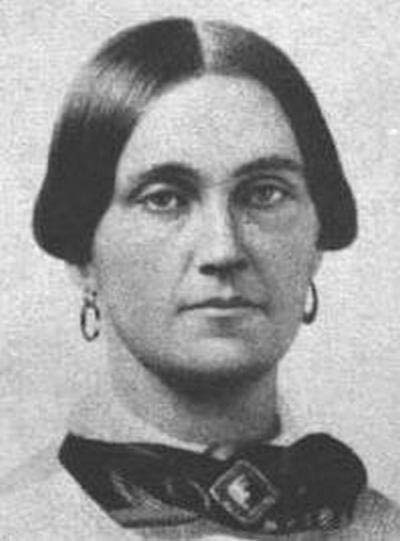Mary Surratt was born on May 1820 or May 1823, on a tobacco farm in southern Maryland in a town called Waterloo. She had 2 brothers: John and James. Her father, Archibald Jenkins, was a non-denominational protestant while her mother Elizabeth Jenkins was an Episcopalian. Mary Surratt started her education on November 25, 1835, at Academy for Young Ladies in Virginia. Despite her parent’s religion background, she converted to Roman Catholicism 2 years after enrolling in the school, adopting a baptismal name Maria Eugenia.
Marriage Life
Mary Surratt married her husband John Surratt in 1940 when she was 17 years old. John was an orphan who was adopted by a wealthy couple from Washington D.C., Mr. and Mrs. Richard Neale. After their wedding in August 1940, the couple moved to Oxon Hill Maryland where John Surratt had purchased a mill. The couple had 3 children: Isaac (1841), Elizabeth “Anna” (1843), and John Jr. (1844). When Richard Neale died in 1843, John and Mary Surratt went back to the District of Columbia. Mary got involved in raising funds to construct St. Ignatius Church in Oxon Hill, although his husband did not approve this. He started to drink heavily and became abusive to his wife. In 1851, their house burned to the ground and Mary moved to Clinton with her children. On the other hand, John got a job on the Orange and Alexandria Railroad. Mary moved back in with his husband in December 1853.
Life during the Civil-War
When the Civil-War broke out on April 1861, the Suratts were Confederate sympathizers. In fact, their tavern used to host fellow sympathizers on a frequent basis, while Confederate spies used it as a safe house. On March 7, 1861, Isaac Surratt traveled to Texas and got enlisted in the Confederates States troops. His brother John Jr. on the other hand, quit his studies in July 1861 and started working for the Confederate Secret Service as a courier. John Surratt Sr. died August 25, 1862 after suffering from stroke. Mary Surratt along with Anna, moved to Washington D.C. on October 1, 1864 to a property which was previously bought by John Sr. Since the family had bad debts, Mary rented the Surrattsville tavern. She also started to rent rooms in her Washington boardinghouse.
Assassination of Abraham Lincoln
During the Civil War, John Junior became a Confederate spy and he met the person who killed President Abraham Lincoln: John Wilkes Booth. Booth, together with several other co-conspirators, was a regular visitor to the boardinghouse, but it remains unclear whether Mary Surratt knew what their meetings were about. Some of the co-conspirators hid 2 Spencer carbines in the spars of an uncompleted loft in a leased tavern of John Lloyd.
Mary Surratt traveled to Surrattsville on April 11, 1865 along with Louis J. Weichmann. During the trip, she met John Lloyd and informed him that the shooting irons would be required soon. On April 14, Mary traveled yet again to Surrattsville. Before the trip, Booth went to the boardinghouse and had a private conversation with Mary Surratt. According to Lloyd, Mary delivered Booth’s binoculars and asked Lloyd to ready the hidden weapons at the tavern. Booth shot the President on April 14, 1865 at Ford’s Theater. John Surratt Jr. fled to Canada and then to Europe posing as a Canadian citizen. He was later arrested in 1866 by U.S. officials in Egypt.
Mary’s Arrest and Incarceration
After the shooting, Members of the District of Columbia police went to Surratt’s boarding house on April 15, 1865 at about 2 A.M. Their intention was to arrest John Jr. and Wilkes Booth. John Surratt was linked with the attack of William H. Seward (Secretary of State). When asked on the whereabouts of her son, Mary lied that he had traveled to Canada 2 weeks ago. Also, she did not reveal that she had delivered a package on behalf of Booth to the tavern. On April 17, Federal soldiers visited the boardinghouse and found Booth’s picture in Mary’s room. Other items found during the search included: pistol, percussion caps, and pictures of Confederate leaders. One of the conspirators to assassinate the president, Lewis Powell, arrived at the boardinghouse as Mary was being arrested. Although she denied knowing him, Lewis was arrested and was later identified as the person who tried to assassinate the Secretary of State.
After her arrest, Mary Surratt was held to Old Capitol Prison and later on she was later taken to the Washington Arsenal. Her trial begun on May 9 and was conducted by a military tribunal. Mary was charged with aiding, counseling, abetting, and housing her 7 co-defendants. She was found guilty of all charges except 2 and was condemned to death. Powell was also found guilty but on learning his sentence, he said that Mary was innocent. Mary was hanged to death on July 7, 1865.
